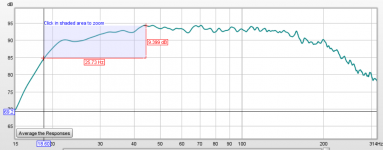I designed a speaker using WinISD to have a -3db @ 21.5 hz and -10db at 17.2 Hz. However when I actually measure the speaker I get a much steeper drop off. Between 37 and 23 hertz the real sub-woofer drops 15 db whereas the simulated sub-woofer falls only 2.5db.
The simulation was done with the measured T/S parameters of the driver after break in. The port length is correct to within a couple millimetres. The box volume takes into account the speaker, port and bracing displacement. The air velocity in the port is 2% of the speed of sound at this volume so I dont think there is any port compression. I have tried varying Ql, the leakage loss, in simulation but it does not have a dramatic effect that would explain the discrepancy.
This is my first speaker build, so I am really at a loss to explain this. If anything I expected the low end to fall more smoothly due to room gain, but I see the opposite. There is a room mode at 37 hz which might explain a little constructive interference there, but as I understand it that would explain at most 3db of the 15db discrepancy.
Any ideas of explanations, or other tests I should do to understand what is happening?
The simulation was done with the measured T/S parameters of the driver after break in. The port length is correct to within a couple millimetres. The box volume takes into account the speaker, port and bracing displacement. The air velocity in the port is 2% of the speed of sound at this volume so I dont think there is any port compression. I have tried varying Ql, the leakage loss, in simulation but it does not have a dramatic effect that would explain the discrepancy.
This is my first speaker build, so I am really at a loss to explain this. If anything I expected the low end to fall more smoothly due to room gain, but I see the opposite. There is a room mode at 37 hz which might explain a little constructive interference there, but as I understand it that would explain at most 3db of the 15db discrepancy.
Any ideas of explanations, or other tests I should do to understand what is happening?
Attachments
Measure outside. The room has at least as much effect on measurements as the speaker at subwoofer frequencies. Gating won't help at these frequencies. If you can't measure outside at least get an extreme nearfield measurement of the port for a bit better idea of low end roll off. Your sim software should let you look at port output alone.
And ideally try to use something better than winisd.
And ideally try to use something better than winisd.
Last edited:
What's your measurement mic position? Looks to me like it's close to the cone, and it's showing a low-20s tuning.
Also worth doing a loop-through of your signal path to see if there's any electrical rolloff influencing things.
Chris
Also worth doing a loop-through of your signal path to see if there's any electrical rolloff influencing things.
Chris
You have response dips in 20Hz and 40Hz. Possible room modes.
Measure outside, preferably away from buildings
Measure outside, preferably away from buildings
And ideally try to use something better than winisd.
Do you have any suggestions? This list is very exhaustive to the point of including apparently bad options like winISD Speaker Design : Comprehensive list of Recommended Design Tools
I like Hornresp. If you want your sims to match your measurements you need accurate sims and the more info the better. Hornresp is capable of more accurate sims. In certain situations winisd can be close enough but sometimes it's not.
- Home
- Loudspeakers
- Subwoofers
- Troubleshooting Unexpectedly Steep Drop Off on Low End


